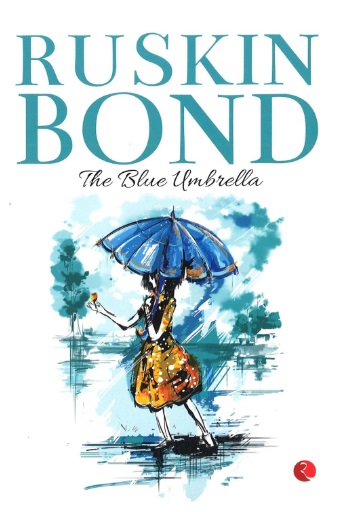
By Ruskin Bond
Ruskin Bond’s The Blue Umbrella is a heartwarming novella that captures the simplicity and charm of rural life in India. Set in a small Garhwal village in the Himalayas, the story reflects the beauty of human emotions, moral dilemmas, and the innocence of childhood.
The central character, Binya, is a young girl who becomes the proud owner of a beautiful blue umbrella. The umbrella, with its vivid color and delicate design, becomes a symbol of envy and admiration among the villagers. Ruskin Bond masterfully uses this seemingly simple object to explore deeper themes such as materialism, kindness, and the importance of letting go.
The narrative primarily revolves around Binya and the village shopkeeper, Ram Bharosa. Ram Bharosa’s envy of the umbrella leads to a series of events that highlight human flaws and the redemptive power of forgiveness. Bond’s portrayal of Ram Bharosa’s eventual change of heart showcases his skill in presenting characters that are both relatable and morally layered.
What makes The Blue Umbrella truly special is Ruskin Bond’s vivid descriptions of the Himalayan landscape. The picturesque setting, combined with his evocative storytelling, transports readers to the serene and rustic world of the mountains. His simple yet poetic language makes the book accessible to readers of all ages.
At its core, The Blue Umbrella is a tale of values. It teaches us that possessions are fleeting and that generosity and understanding are far more fulfilling. The story also emphasizes the innocence of childhood and how small acts of kindness can create lasting impressions.
The novella is not just a children’s book; it holds universal appeal. Its brevity and simplicity make it an easy read, yet its profound message lingers long after the last page is turned. Ruskin Bond’s storytelling is a gentle reminder of the beauty of a life unspoiled by greed and the joy of embracing simplicity.
Ruskin Bond’s The Blue Umbrella is a heartwarming novella that captures the simplicity and charm of rural life in India. Set in a small Garhwal village in the Himalayas, the story reflects the beauty of human emotions, moral dilemmas, and the innocence of childhood.
The central character, Binya, is a young girl who becomes the proud owner of a beautiful blue umbrella. The umbrella, with its vivid color and delicate design, becomes a symbol of envy and admiration among the villagers. Ruskin Bond masterfully uses this seemingly simple object to explore deeper themes such as materialism, kindness, and the importance of letting go.
The narrative primarily revolves around Binya and the village shopkeeper, Ram Bharosa. Ram Bharosa’s envy of the umbrella leads to a series of events that highlight human flaws and the redemptive power of forgiveness. Bond’s portrayal of Ram Bharosa’s eventual change of heart showcases his skill in presenting characters that are both relatable and morally layered.
What makes The Blue Umbrella truly special is Ruskin Bond’s vivid descriptions of the Himalayan landscape. The picturesque setting, combined with his evocative storytelling, transports readers to the serene and rustic world of the mountains. His simple yet poetic language makes the book accessible to readers of all ages.
At its core, The Blue Umbrella is a tale of values. It teaches us that possessions are fleeting and that generosity and understanding are far more fulfilling. The story also emphasizes the innocence of childhood and how small acts of kindness can create lasting impressions.
The novella is not just a children’s book; it holds universal appeal. Its brevity and simplicity make it an easy read, yet its profound message lingers long after the last page is turned. Ruskin Bond’s storytelling is a gentle reminder of the beauty of a life unspoiled by greed and the joy of embracing simplicity.
Availability
available
Original Title
The Blue Umbrella
Series
Publish Date
1992-01-07
Published Year
1992
Publisher, Place
Total Pages
90
ISBN 10
9788171673407
ISBN 13
978-8171673407
ASIN
8171673406
Format
Paper cover
Language
English
Dimension
20.32 x 12.7 x 1.27 cm
Weight
60 g
Average Ratings
Readers Feedback
Gunjal Arpita Bharat
The Blue umbrella is hart warming tale set in a small village in Himachal pradesh. The story revoires around the little girl named Binya,who trades...Read More
Vishal Jadhav
Gunjal Arpita Bharat
The Blue umbrella is hart warming tale set in a small village in Himachal pradesh.
The story revoires around the little girl named Binya,who trades her lucky leopard low pendant for a beautiful blue umbrella from a group of tourists.the umbrella becomes the pride of her village & a source of energy for others.
Ram Bharosa ,the local shopkeeper,corets the umbrella & tries various ways to acquire it. His graced drives him to a desperate act,but it caught & humiliated by the villagers.
Despite the betrayal ,Binya decides to forquer Ram Bharosa & gifts him the umbrella,teaching a powerful lesson in kindness & selflessness. The strong beautifully captures human emotions,the simplicity or village life & the moral that genericity and forgiveness hold more value than material possessions
The Blue Umbrella
Ruskin Bond’s The Blue Umbrella is a heartwarming novella that captures the simplicity and charm of rural life in India. Set in a small Garhwal...Read More
Dr Rohan Dahivale
Amazing book
Dr. Rohan P. Dahivale Professor Rajgad Institute of Management Research & Development, Pune 411043Read More
